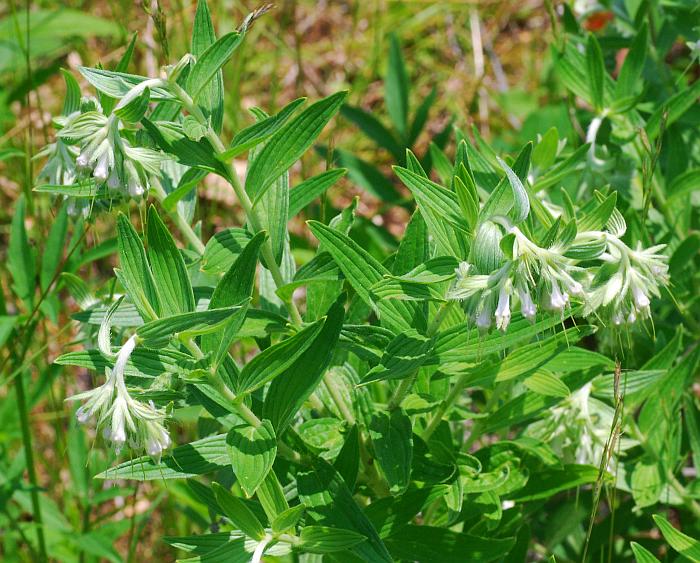Onosmodium molle Michx.
Western False Gromwell

Native
CC = 4
CW = 5
MOC = 49
© SRTurner
Onosmodium molle Michx.Western False Gromwell | |
 |
Native CC = 4 CW = 5 MOC = 49 |
© SRTurner |
|
Family - Boraginaceae Habit - Perennial forb with stout, woody rootstock. Stem - Arched to ascending, to 1.2 m, sometimes multiple, sometimes branched, glabrous to densely hairy.
Leaves - Alternate, simple, sessile or nearly so. Lowest leaves withered and absent at flowering. Blades 2-14 cm long, 10-40 mm wide, lanceolate to ovate, angled or tapered at the base, angled or tapered to a sharply pointed tip, the upper surface densely pubescent with appressed to spreading, stiff, pustular-based hairs, the undersurface moderately to densely pubescent with softer, sometimes nonpustular-based hairs, with 2-4 prominent pairs of lateral veins, these usually strongly impressed on the upper surface and strongly ridged on the undersurface.
Inflorescence - Often paired, terminal, appearing as dense clusters at the start of flowering, becoming elongated into scorpioid, spikelike racemes, the flowers with stalks 0.3-1.0 mm long at flowering, these elongating to 1.5-3.0 mm at fruiting, ascending, each flower subtended by a leaflike bract 10-35 mm long.
Flowers - Calyces actinomorphic, 5-lobed nearly to base, the lobes 3.5-9.0 mm long at flowering, elongating slightly at fruiting, linear to narrowly narrowly oblanceolate, densely hairy on both surfaces, persistent and ascending at fruiting. Corollas 7-16 mm long at full flowering, tubular with a small bulge in the throat, actinomorphic, white to cream-colored or greenish yellow, hairy on the outer surface, the tube 5-12 mm long, the lobes 2-4 mm long. Stamens inserted near the tip of the corolla tube, the filaments very short, not or only slightly exserted from the corolla. Ovary deeply 4-lobed, the style elongate, strongly exserted from the corolla, persistent at fruiting, stigma capitate, shallowly 2-lobed.
Fruits - Schizocarps dividing into mostly 1 or 2 nutlets, these 2.5-5.0 mm long, ovoid, sometimes with a shallow ventral groove or an indistinct, blunt ventral ridge, white to ivory-colored or brownish-tinged, attached to the flat gynobase at the base, the attachment scar relatively large, the surface smooth or rarely minutely pitted, sometimes shiny.
Flowering - May - August. Habitat - Glades, savannas, forests, bluff tops, prairies, fields, roadsides, often on calcareous substrate. Origin - Native to the U.S. Lookalikes - Broadly, Lithospermum latifolium. Other info. - This interesting and striking species is fairly common in Missouri, found predominantly in the southern 2/3 of the state. The subspecies pictured above, ssp. subsetosum, is quite limited in its U.S. distribution, being almost entirely confined to Missouri and states adjacent to the south. In Missouri this is the most common of the three subspecies present in the state. Photographs taken at Cuivre River State Park, Lincoln County, MO, 6-13-2009, St. Joe State Park, St. Francois County, MO, 5-25-2010 and 6-10-2013, Shaw Nature Reserve, Franklin County, MO, 6-18-2011 and 8-21-2021, and Little Lost Creek Conservation Area, Warren County, MO, 6-3-2018 and 6-10-2019 (SRTurner). |